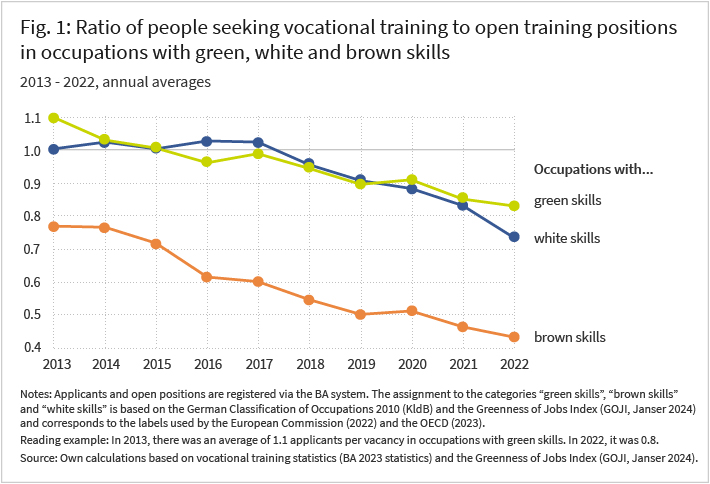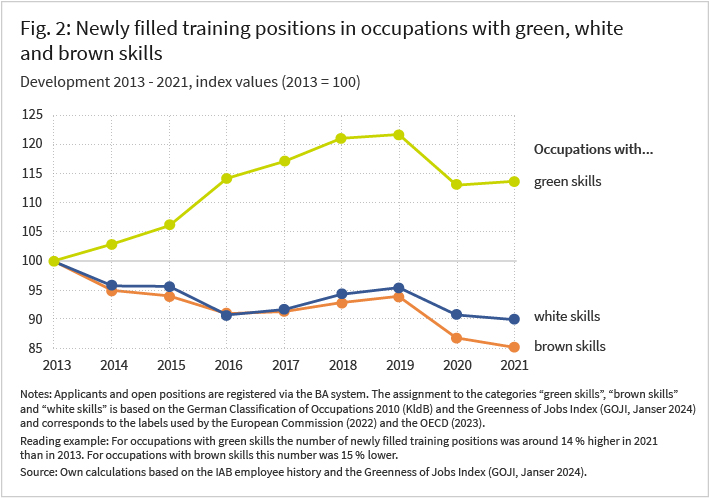12. June 2024 | Digital and ecological transformation
Vocational training: Occupations with green skills are in high demand

The current ecological crises, and above all climate change, require a restructuring of the economy. The aim of this ecological transformation is to replace production methods which are harmful to the environment and contribute to climate change with ecologically sustainable processes and technologies. However, many of these “green” technologies require specially-trained personnel, resulting in a growing need for skilled workers in environmentally and climate-friendly occupations. In the German case, dual vocational training plays a central role for meeting this need.
At the same time, the large cohort of baby-boomers born in the 1950s and 1960s are going to reach retirement age in the coming years. Yet, the cohorts that leave school in the next years are comparatively small. This development is likely to further reduce the number of skilled workers on the labour market overall and is already felt in the vocational training system today: Problems with matching have intensified, and the number of unfilled training positions have shot up in recent years, as described by Bernd Fitzenberger et al. (2022) and Ute Leber et al. (2023).
Applicant numbers decline most sharply in jobs with “brown” skills
According to the vocational training statistics from the German Federal Employment Agency (BA), the total number of applicants for training positions fell sharply between 2013 and 2022. In 2013, 523,000 people were looking for a training position through the BA system. In 2022 this number had shrunk by 21.5 percent, to 402,000. In contrast, the number of vacant training positions reported to the BA grew from 521,000 in 2013 to almost 541,000 (+3.8 %) in 2022.
However, this development was not uniform across occupations. This becomes clear when differentiating between three categories of occupations based on occupation-typical activities, as used by the European Commission (2022) and the OECD (2023), among others: occupations with environmentally- and climate-friendly skills (green skills), occupations with skills that are harmful to the environment and climate (brown skills), and occupations with skills that are neither green nor brown (white skills). Examples of occupations with green skills are occupations in “classic” environmental protection, in the production of renewable energy, but also in plumbing, heating and air conditioning technology. Another example is chimney sweeping, an occupation with an increasing amount of “green” activities in its occupational profile, such as measuring emissions and energy consulting. Occupations with white skills are primarily found in the health and service professions. Examples for occupations with brown skills are occupations in plastics production, livestock farming, and the production of certain building materials.
Amongst young workers, demand for occupations with brown skills fell particularly sharply: For occupations in this category, the number of people seeking vocational training positions through the BA halved from around 59,000 in 2013 to less than 30,000 in 2022. In contrast, the number of people seeking vocational training positions with green skills fell only slightly between 2013 and 2022, from 218,000 to 210,000. Likely causes for these developments are changes in the economy or labour market structure; changes in the orientation of occupations; as well as shifting demand towards occupations that already had green skills in 2013.
The ratio of people seeking vocational training to open training positions is higher for occupations with green skills
A common measure of the shortage of trainees is the ratio of people seeking vocational training to the number of vacant training positions. Figure 1 shows that for occupations with green skills where, on average, there were around 1.1 applicants for each open training position in 2013. In 2022, however, this number dropped to only 0.8. The underlying reason is the sharp increase in demand for workers with green skills: During this period the number of training positions registered with the BA for occupations with green skills rose from 198,000 in 2013 to 251,000 in 2022.
For occupations with brown skills, the significant decline in the number of people seeking vocational training was offset by a moderate decline in open training positions, from 76,000 in 2013 to 68,000 in 2022. Because the number of applicants fell much more swiftly than the number of open positions, this resulted in a sharp decline in the ratio of applicants to open training positions: Between 2013 and 2022, the number of applicants per open training position in occupations with brown skills fell from about 0.8 to about 0.4.

The number of trainees in occupations with green skills has grown significantly
However, a high ratio of applicants to vacancies does not necessarily lead to many newly filled vocational training positions. Figure 2 therefore depicts the development of the number of new trainees in the three occupational categories. The data is available for the years 2013 to 2021. Arguably, the comparably high attractiveness of training occupations with green skills and the strong demand for skilled workers in this area led to an increase in the actual number of newly filled training positions. The increase between 2013 and 2021 was around 14 percent.
In contrast, the number of newly filled training positions in occupations with brown skills was 15 percent lower in 2021 than in 2013. For jobs that cannot be assigned to neither of these two categories, almost 10 percent fewer training positions were filled in 2021 than in 2013.
These results may be driven by a higher demand for occupations that already had green skills in their task profile in 2013, or by demand for occupations that became “greener” over time. An example for the latter type of occupations is “roofing”, for which two green skills – “energy consulting” and “installation of solar thermal energy” – were added to the job profile in 2016. When using the task profiles as of 2013 for the classification of occupations, the development is very similar to the one displayed in Figure 2. This strongly suggests that changing task profiles can only account for a small part of the increase in newly filled training positions with green skills. Almost all of the increase is explained by a growing demand for occupations that already had green skills in 2013.

In regions under high pressure to transform, the number of trainees in occupations with green skills is increasing only slowly
The number of trainees in occupations with brown and green skills may have developed differently across regions. We investigate this possibility using regression analysis.
We use the share of employees in occupations with brown skills in 2013 as an indicator for the regional pressure to transform, i.e. the degree to which the regional labour market was dominated by brown-skill occupations in 2013. The pressure to transform has a statistically significant negative relationship with the change in the number of trainees in occupations with green skills. This means that in regions under high pressure to transform the number of trainees in occupations with green skills increased more slowly from 2013 to 2021 than in other regions. Hence, the ecological transformation of the training system proceeds more slowly in regions with high pressure to transform.
In ageing regions, the number of trainees in occupations with brown skills fell particularly sharply
In regions where an above-average share of people is approaching retirement age and where the share of young people that leave school is comparably small, the workforce is at risk of ageing more rapidly. In these regions, a particularly large number of open training positions are likely to remain unfilled.
The regression analysis shows that in such regions the number of newly filled training positions for occupations with brown skills and for occupations with white skills fell particularly sharply. In contrast, this pattern could not be identified for occupations with green skills.
Table 1 clarifies the magnitude of these relationships. It displays the average percentage change in the number of new training relationships for illustrative cases. In regions with low pressure to transform and a medium ratio of older to younger people, the number of newly-filled training positions for occupations with green skills was 16.1 percent higher in 2021 than in 2013, while in regions with high pressure to transform, growth was only 11.4 percent. For occupations with activities that are harmful to the environment or the climate, the difference between different regions was smaller and was not statistically significant. The growth rates for occupations with white skills, on the other hand, do not differ between regions with low or high pressure to transform.
As further illustrative examples, we consider regions with medium pressure to transform against a varying degree of ageing. The decline in newly-filled training positions for occupations with brown skills varies greatly with the degree of ageing: In regions with medium pressure to transform and a low degree of ageing, the shrinkage was 6.3 percent, whereas in otherwise similar districts with a high degree of ageing, the decline was much greater at 22.8 percent. The decline in training for occupations with white skills also varies with the degree of ageing, although the connection is somewhat weaker in this case. In contrast, the growth in occupations with green skills differed far less between otherwise similar regions with low or high levels of ageing.

Conclusion
This analysis shows that despite a decline in the overall number of applicants between 2013 and 2022, the number of newly filled training positions for occupations with green skills has increased. Growth was above average in regions where already in 2013 relatively few employees worked in occupations with brown skills. Arguably, these regions had a head start into the ecological transformation.
In contrast, the lack of applicants is much more severe in occupations with brown skills. The number of newly filled training positions for occupations with brown skills fell by 15 percent from 2013 to 2021 – potentially due to a realignment of companies towards more ecological processes. This development was particularly serious in ageing regions.
However, many occupations with brown skills will still be needed in the future. In order for these occupations to once again become attractive, two changes are required: First, occupations in which brown skills currently play a major role need to become more environmentally and climate-friendly overall. And second, the training content of all occupations – especially those with brown skills – should be adapted so that trainees are prepared for more ecologically sustainable tasks in the future and thus can help to drive the transformation forward.
Over time, more environmentally and climate-friendly skills can be added to all occupations and this “greening” would bolster the ecological transformation. The very positive development of the number of trainees in occupations with green skills suggests that the “greening” of training courses can also increase their attractiveness – not least because these occupations become potentially more sustainable and thus offer the trainees a better, longer-term perspective on the labour market.
In Brief
- Climate action requires a restructuring of the economy towards more ecologically sustainable technologies with a significantly reduced use of fossil fuels. This suggests a growing need for skilled workers in occupations with green skills.
- At the same time, the large baby boomer cohorts will be retiring in the coming years, whilst upcoming younger cohorts are comparably small.
- Despite the general lack of trainees, the number of newly-filled training positions for occupations with environmentally- and climate-friendly occupational content (occupations with green skills) increased by 14 % between 2013 and 2021.
- In regions where in 2013 a relatively high proportion of employees worked in occupations with ecologically harmful activities (occupations with brown skills), the proportion of trainees in occupations with green skills rose more slowly than average.
- The number of newly-filled training positions in occupations with brown skills was around 15 % lower in 2021 than in 2013. This decline was particularly significant in ageing regions.
- The positive development of the number of trainees in occupations with green skills suggests that the “greening” of occupations also increases their attractiveness.
Literature
European Commission (2022): Green Skills and Knowledge Concepts: Labelling the ESCO Classification – Technical Report 2022. European Commission: Employment, Social Affairs and Inclusion, Green Skills and Knowledge – Labelling ESCO. Brussels.
Fitzenberger, Bernd; Heusler, Anna; Houstecká, Anna; Wicht, Leonie (2022): Stellenangebot, Bewerbungen und neue Ausbildungsverträge: Passungsprobleme am Ausbildungsmarkt nehmen in der Corona-Krise weiter zu. IAB-Kurzbericht 19/2022.
Janser, Markus (2019): The greening of jobs: Empirical studies on the relationship between environmental sus- tainability and the labor market. Doctoral dissertation, Otto-Friedrich-Universität Bamberg, 213.
Janser, M. (2024): The Greenness of Jobs Index (GOJI): A Task-Based Index to Analyse the Impact of the Ecological Transition on the Labour Market. Mimeo.
Leber, Ute; Roth, Duncan; Schwengler, Barbara (2023): Die betriebliche Ausbildung vor und während der Corona- Krise: Besetzungsprobleme nehmen zu, Anteil der Betriebe mit Ausbildungsberechtigung sinkt. IAB-Kurzbericht 3/2023.
OECD (2023): Assessing and Anticipating Skills for the Green Transition: Unlocking Talent for a Sustainable Future, Getting Skills Right, OECD Publishing, Paris.
Statistik der Bundesagentur für Arbeit (2023): Ausbildungsmarktstatistik. Stand: 15. Februar 2023 (MSTR-MOLAP). Sonderauswertungen 2013–2022.
DOI: 10.48720/IAB.FOO.20240612.01
Brixy, Udo; Janser, Markus; Mense, Andreas (2024): Vocational training: Occupations with green skills are in high demand, In: IAB-Forum 12th of June 2024, https://iab-forum.de/en/vocational-training-occupations-with-green-skills-are-in-high-demand/, Retrieved: 27th of December 2025
Diese Publikation ist unter folgender Creative-Commons-Lizenz veröffentlicht: Namensnennung – Weitergabe unter gleichen Bedingungen 4.0 International (CC BY-SA 4.0): https://creativecommons.org/licenses/by-sa/4.0/deed.de
Authors:
- Udo Brixy
- Markus Janser
- Andreas Mense

 Dr Udo Brixy is a senior researcher in the research unit "Regional Labour Markets" at the IAB.
Dr Udo Brixy is a senior researcher in the research unit "Regional Labour Markets" at the IAB. Dr Markus Janser is a senior researcher at the IAB.
Dr Markus Janser is a senior researcher at the IAB. Dr Andreas Mense has been a research associate in the Regional Labour Markets department at the IAB since October 2021.
Dr Andreas Mense has been a research associate in the Regional Labour Markets department at the IAB since October 2021.